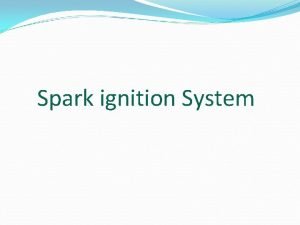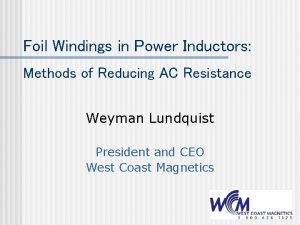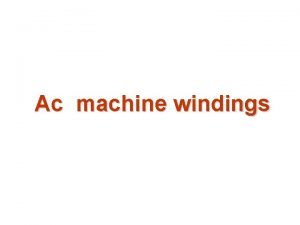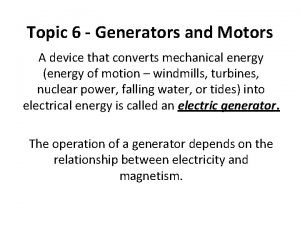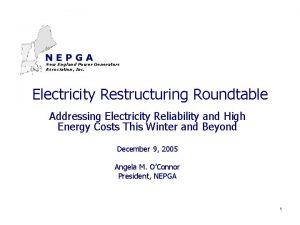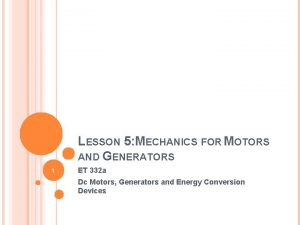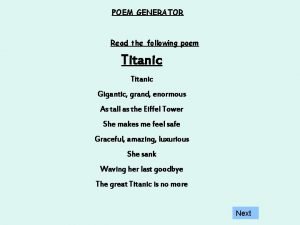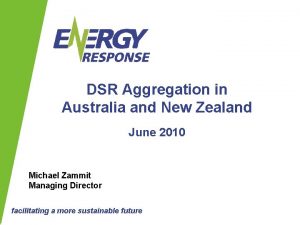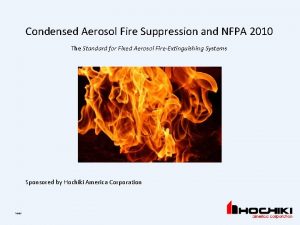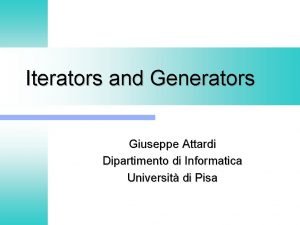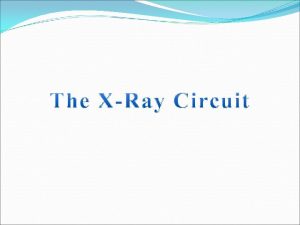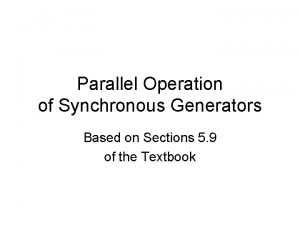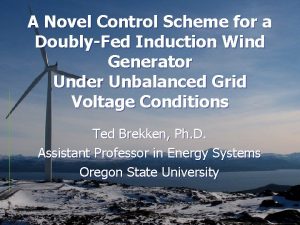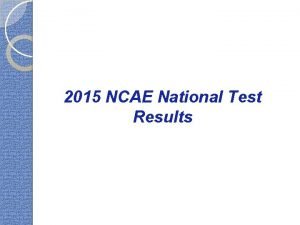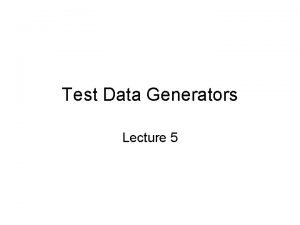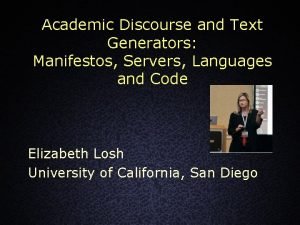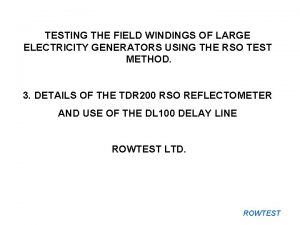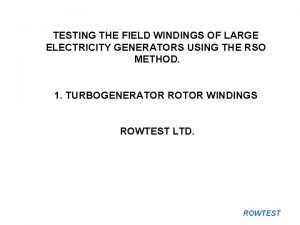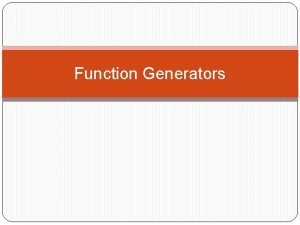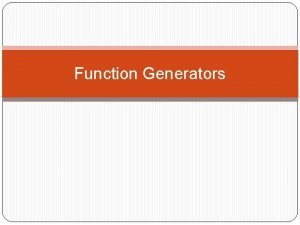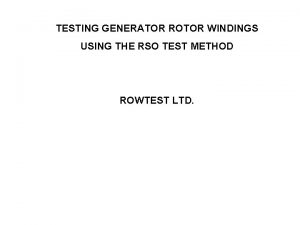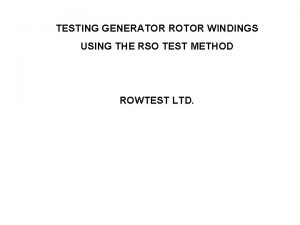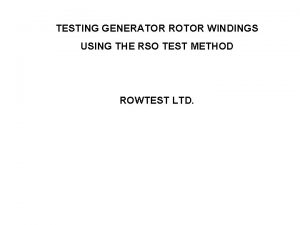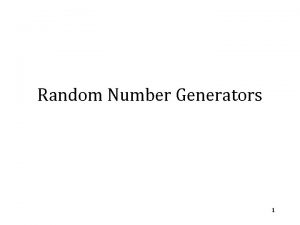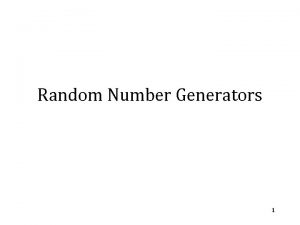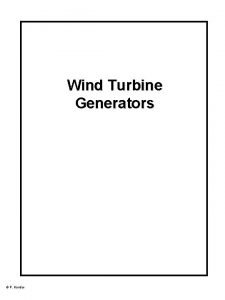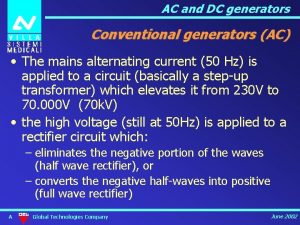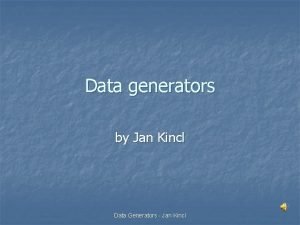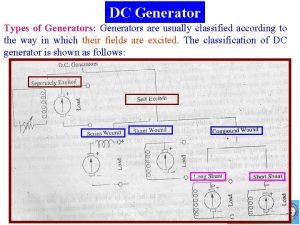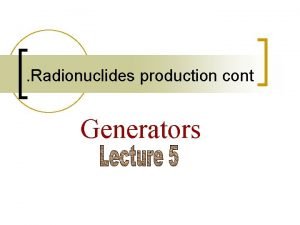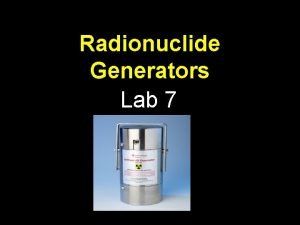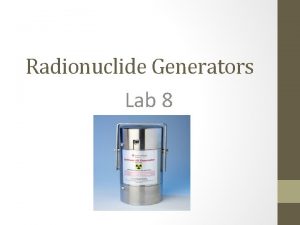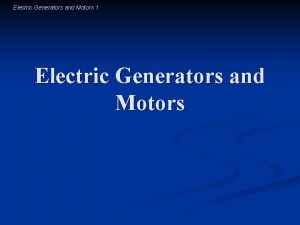TESTING THE FIELD WINDINGS OF LARGE ELECTRICITY GENERATORS












































- Slides: 44

TESTING THE FIELD WINDINGS OF LARGE ELECTRICITY GENERATORS USING THE RSO METHOD. 2. AN INTRODUCTION TO THE RSO TEST ROWTEST LTD. ROWTEST

INTRODUCTION TO THE RSO TEST The RSO (Recurrent Surge Oscillograph) test was developed to detect and locate faults in the field windings of large turbo-alternator rotor windings. It uses a modified form of time domain reflectometry (TDR) to apply a D. C. voltage step (or pulse) between each end of the rotor winding and the rotor body in turn. The resulting waveforms are monitored and compared, allowing any winding faults (particularly inter-turn faults) to be detected and located. The test was invented by A. E Grant of the UK Central Electricity Board (CEGB) in 1971. Some useful practical information about the RSO test is contained in the following conference paper, from which some content in this presentation (including the comments in the next 2 slides) has been copied with permission: ROWTEST

ROWTEST

ROWTEST

WHAT IS THE RSO TEST USED FOR? Testing the windings of turbogenerator rotors to detect and locate: 1. Short-circuits between turns (shorted turns). 2. Short-circuits to ground (earth faults) 3. High-resistance joints. The test relies on 2 basic principles: ROWTEST

PRINCIPLE 1. SYMMETRY PROPERTIES All cylindrical rotor windings are symmetrical when viewed from each end of the winding. For example, a 2 -pole rotor contains two nominally-identical half -windings, one for the North pole and the other for the South pole, both of which are connected in series. A four pole rotor is similarly symmetrical. Representation of a 2 -pole rotor winding showing the identical North and South pole half-windings ROWTEST

PRINCIPLE 2. TRANSMISSION LINE APPROXIMATION Cylindrical rotor windings can be approximated as electrical transmission lines, which have an overall characteristic or wave impedance (similar to that of a coaxial cable) This occurs because the field conductors of the rotor winding sit largely within enclosed metal slots in the rotor forging. Consequently, if an electrical pulse is applied between one end of the winding and the rotor body, it will travel through the winding to the far end where it will emerge after a finite time delay. The RSO test method uses transmission line measurement techniques, as described later, to identify (and locate approximately) any faults in the rotor winding. Winding faults will cause the wave impedance to decrease at the fault location. This changes the shape of the RSO waveforms, allowing the fault to be identified and its approximate location found. ROWTEST

RSO TEST FUNDAMENTALS These symmetry and transmission line properties are used to compare the response of the rotor winding to voltage pulses applied in turn between each slipring (or winding end) and the rotor body. Although the applied RSO pulse is often has a good rectangular waveform, the electrical properties of the rotor winding modify the pulses as they pass through the winding. The resulting modified pulse waveforms are monitored at both (input and output) ends of the rotor winding and appear as shown below for a typical fault-free rotor winding. Input end RSO waveforms Output end RSO waveforms ROWTEST

RSO TEST FUNDAMENTALS The RSO pulses are applied at each end (slip ring) of the winding in turn and the resulting 2 input end waveforms are compared. In the Rowtest TDR 100 and TRD 200 RSO test systems, this is done automatically, allowing the waveforms at the INPUT ENDS of the winding to be superimposed for viewing in real-time. The (pair of) RSO pulse waveforms at the remote (OUTPUT) end of the winding are used to measure the time taken for the pulse to travel from the INPUT end to the OUTPUT end. This transit time is used as a reference value in the calculation to find the approximate location of any winding faults as shown later. The pairs of superimposed RSO pulse waveforms at the INPUT ends of the winding are complex waveforms, caused by multiple reflections which occur every time there is a change in the wave impedance of the rotor winding (including those caused by winding faults to ground or between turns). Comparing the pair of superimposed input end waveforms allows any winding faults to be detected and located ROWTEST

RSO TEST FUNDAMENTALS If the rotor winding is fault-free, two identical waveforms will be observed for the input end pulses injected at each slip ring. However, if one half-winding contains a fault, the two input end waveforms will differ. It should be noted that even for a fault-free winding, there will be multiple reflections within the rotor winding at each change in wave impedance. This occurs primarily between the long sections of conductors inside the radial slots and the shorter sections in the cross-over end regions, where the wave impedance is higher. The result is complex RSO waveforms which are difficult to interpret in isolation. However, the rotor symmetry property ensures that the 2 waveforms monitored at the input ends of the winding will always be identical for a fault-free rotor under normal test conditions. However, if the superimposed input end waveforms are not identical, the likely cause is a fault in the winding. ROWTEST

HISTORY OF THE RSO TEST The RSO (Recurrent Surge Oscillograph) test was developed to detect and locate faults in the field windings of large turbo-alternator rotor windings. It uses a modified form of time domain reflectometry to apply D. C. voltage step (or pulse) between one end of the rotor winding and the rotor body and monitoring and comparing the resultant waveforms. It was first described in a paper by A. E Grant in 1971. Grant used a square pulse train generated by a simple electronic circuit and the Rowtest Reflectometer is based on this concept. Some other suppliers (eg Sumatron) use a short pulse which is injected at both ends of the winding simultaneously. The principle of operation of both methods is similar, but the resulting RSO waveforms look very different. ROWTEST

ROWTEST

Grant’s RSO Pulse Generator ROWTEST

Connections to Rotor ROWTEST

PRINCIPLE OF OPERATION OF THE RSO TEST (ROWTEST VERSION) A low-voltage pulse (12 V) is applied between one of the rotor slip rings and ground and the transmitted pulse received at the remote end of the rotor (C 2) and the reflected pulse at the sending end (C 1) are monitored as shown below. A pair of adjustable resistors (RV 1 and RV 2) are set to match the pulse generator and terminating resistor to the wave impedance of the rotor winding (typically in the range 30 - 1000 Ohms). This ensures that the winding is tested under repeatable conditions and minimises multiple reflections of the pulse within the winding. ROWTEST

RSO WAVEFORMS FOR A FAULT-FREE ROTOR WINDING The RSO test is carried out by applying pulses from each end of the rotor winding in turn and the RSO waveforms at each end of the winding are recorded and compared. If the rotor is fault-free, the oscilloscope traces will be identical as shown below. C 2 (output ends) No fault C 1 (input ends) No fault Typical RSO Oscilloscope waveforms for a fault-free rotor winding C 1 (input ends) Earth fault Inter-turn fault ROWTEST

MODIFIED GRANT CIRCUIT USED IN THE TDR 200 REFLECTOMETER In practice, the TDR 100/200 test instruments apply pulses alternately from each end of the rotor winding via an internal electronic changeover switch as shown above. Although the TDR 200 can be used with an oscilloscope to view the RSO waveforms when operating in its simple Analogue mode, in its normal Digital mode of operation, these waveforms are displayed directly on the screen of a Control PC. ROWTEST

RSO WAVEFORMS FOR FAULTY ROTOR WINDINGS If there is a fault in the rotor winding, the RSO waveforms measured on the C 1 (input ends) channel will resemble those shown below for an earth and interturn fault respectively. C 1 (input ends) Inter-turn fault Earth fault Typical RSO oscilloscope waveforms for rotors with earth and interturn faults ROWTEST

RSO TEST METHODS There are 2 different RSO test methods in common use. 1. The long pulse alternate-end excitation (Grant) method. This is the method used in the Rowtest TDR 200 equipment 2. The short pulse simultaneous excitation method which is used in the Sumatron RSO equipment. Both methods use the same principle of operation, but display very different RSO waveforms. For completeness, we have given examples of waveforms using the short pulse method in the following slides and compared them with those obtained using the Rowtest equipment. ROWTEST

SHORT PULSE (Sumatron) VERSION Note that in the Sumatron equipment, short pulses are injected from both ends of the winding simultaneously. ROWTEST

EXAMPLE OF RSO WAVEFORMS USING THE SHORT-PULSE METHOD SHORT PULSE VERSION Note that the one of the waveforms has been displaced vertically for clarity. For each of the blue and yellow waveforms, the first peak corresponds to the pulse injected from one end of the winding and the second peak is caused by that injected from the remote end. ROWTEST

EXAMPLES OF RSO WAVEFORMS OBTAINED USING THE LONG PULSE METHOD (SHOWING 2 SUPERIMPOSED WAVEFORMS) Input end RSO waveforms for a fault-free winding Output end RSO waveforms for a fault-free winding ROWTEST

ROWTEST

ROWTEST

TRANSMISSION AND DELAY LINES In this section we explain how the RSO test uses transmission line measurement techniques to detect and locate faults in rotor windings. We then show a simple electrical model of a transmission line can be realised using basic electrical components to construct a delay line which can be used to demonstrate the RSO method without the need for access to a real rotor winding. The most common example of a transmission line is the coaxial cable which connects the aerial to a television. Transmission line properties must be considered when the length of a circuit conductor becomes comparable with the wavelength of the applied signal (or its components). ROWTEST

TRANSMISSION LINE PROPAGATION (UNIVERSITY OF SINGAPORE) ROWTEST

(UNIVERSITY OF SINGAPORE) ROWTEST

ROTOR CONDUCTOR CONFIGURATION INSIDE RADIAL SLOTS The windings of a typical cylindrical rotor are contained within rectangular slots machined radially into the steel rotor forging. The figure shows the cross-section of a typical radial slot (in this case, containing 7 turns of insulated copper bar) This rotor winding geometry approximates to a high-frequency transmission line (similar to a coaxial cable), as the conductors sit within an enclosed metal screen formed by the slots in the rotor forging. (GE Power Systems) This property is used in the RSO test to identify and locate approximately any faults in the rotor winding. ROWTEST

RSO PULSE PROPAGATION When an electrical pulse is applied between one end of the rotor field winding and the rotor body (ground), it will take a finite time (T 1 seconds ) to travel through the winding before it emerges at the far end of the winding. The pulse travels at a speed which is a fraction of the velocity of light and, T 1 is known as the single-pass transit time. For a typical rotor field winding, T 1 is a few tens of microseconds. ROWTEST

C 2 (output ends) No fault C 1 (input ends) No fault INPUT ENDS OUTPUT ENDS These are typical RSO waveforms monitored at the input and output ends of a C 1 (input ends) fault-free rotor winding. Note the distorted output waveform and time delay (T 1). Earth fault Inter-turn fault ROWTEST

RSO PULSE PROPAGATION The rotor field winding has a number of transmission line properties, including a finite transit time (T 1) and also a well-defined wave impedance Z 0. We can therefore approximate the field winding by an equivalent length of transmission line as shown above. To avoid the need for a real rotor for demonstrating the RSO test, we would prefer to have a portable rotor winding simulator. However, as the pulse travels near the speed of light (3 x 10^8 m/S), in 1 u. S it will travel around 300 metres. So to simulate a rotor winding with a transit time of eg 20 u. S, we would need 300 x 20 = 6000 metres of coaxial cable. ROWTEST

DELAY LINE APPROXIMATION TO ROTOR WINDING This would be impractical, but fortunately, a transmission line can be approximated by an equivalent circuit of a series of L/C circuits, known as a delay line. A simple 10 -section delay line of this type is supplied with each TDR 200 system. It has a delay time of 1 u. S per section (10 u. S overall) and a wave impedance (Z 0) of 100 Ohms The next few slide shows how a pulse propagates through an ideal transmission line. ROWTEST

The figure shows how a long pulse travels through an ideal transmission line. The waveforms viewed at the input ends of the delay line depend on how the output end is terminated. Note the time delays Td (=T 1) and the changes to the input end waveforms after the reflections from the end of the delay line at time 2 x. Td. ROWTEST

This slide shows idealised and actual RSO waveforms at the input and output ends of an actual fault-free rotor winding, where the output end is terminated in the wave (impedance of the rotor winding. Note that there are 2 superimposed RSO waveforms which have been injected from each end of the winding in turn. Output ends Input ends ROWTEST

EFFECT OF AN EARTH FAULT ON THE WINDING IMPEDANCE If there is a fault in the rotor winding, the wave impedance at this point will decrease and cause part of the pulse to be reflected back to the input ends. This slide shows simplified and actual measured superimposed input end waveforms for a rotor winding with an earth fault. Simplified RSO input end waveforms for an earth fault Short circuit to rotor body at end of 5 th coil slot (16 coils in winding) ROWTEST

EFFECT OF A SHORTED TURN The wave impedance of a rotor winding with a shorted turn also decreases at the fault location and the 2 superimposed RSO waveforms form a loop, as the reduction in wave impedance occurs at different times for pulses injected from each end of the winding (unless the fault is in the centre of the winding). Measured waveforms for a rotor winding with a single shorted turn. ROWTEST

EFFECT OF A SHORTED TURN ON WAVE IMPEDANCE The reason for the reduction in impedance at a shorted turn can be explained by considering the effect on the incident pulse of a single shorted turn. At the short location, the injected pulse can travel around one of several possible alternative transmission line paths as shown and the wave impedances of these paths are all in parallel, so reducing the wave impedance at this point. This will occur first for the pulse injected from the end nearest the short and then again for the pulse injected from the end remote from the fault, so forming a loop in the superimposed waveforms. ROWTEST

TDR 200 RSO WAVEFORMS FOR DEMONSTRATION DELAY LINE These effects can be demonstrated using the DL 100 delay line. The figures below show the RSO waveforms at the input and ends of the rotor winding for the delay line with no faults applied. These show 2 perfectlysuperimposed waveforms. Input end waveforms Output end waveforms ROWTEST

SIMULATED WINDING FAULTS APPLIED TO A DELAY LINE The slides shown here show the input end waveforms when inter-turn and ground faults are applied to the same delay line. The red waveform corresponds to the pulse injected from end 1 of the winding and the blue waveforms to that from end 2. The green waveform is the difference between the red and blue waveforms. Shorted turn between terminals 4 and 5 Earth fault applied to terminal 4 ROWTEST

EFFECTS OF MIS-MATCHING THE DELAY LINE TERMINATING IMPEDANCE R 2 The delay line can also be used to show the effects of mis-matching the terminating impedance R 2 at the output ends of the winding as shown below. R 2 = 200 Ohms R 2 = 10 Ohms (R 1 = 100 Ohms) ROWTEST

LOCATING WINDING FAULTS The location of a single winding fault can be found (approximately) by noting the time at which the input end RSO waveforms start to diverge and comparing this time with 2 x the time taken to pass from one end of the rotor winding to the remote end. The first step is to measure the single pass transit time from the waveforms at the output ends at the rotor winding as shown below. The transit time for the RSO pulse to travel from one end of the winding to the other end is measured as 36. 3 u. S in the output ends waveform plot opposite. ROWTEST

LOCATING WINDING FAULTS When the input end waveforms are viewed for this rotor with an inter-turn fault, the superimposed waveforms start to diverge at 23. 2 u. S from the start of the pulse. So in this case, the shorted turn occurs approximately ((23. 2/(2*36. 3))*100 = 32% of the total winding length from the end of the winding connected to the Reflectometer Red terminal. As this rotor has 16 coils each containing 8 turns, the estimated fault position is in turn 41 ie turn 2 of coil 5 counting from the end connected to the Red terminal. ROWTEST

LOCATING WINDING FAULTS If the rotor has been removed from the generator, a further and more precise method for locating interturn faults is possible. The method is based on applying a similar fault to turns in the fault-free half of the winding and adjusting the position of the applied fault until the 2 input end waveforms are identical (or nearly so). Further details of this technique, which is particularly useful during a rotor winding repair, are given in the TDR 200 Instruction Manuals. ROWTEST

Thank you for viewing this presentation. If you have any questions, please send them to us at enquiries@rowtest. com. We will try to respond to you as soon as we can. ROWTEST
 Ignition coil windings
Ignition coil windings Aluminum winding dry type transformer
Aluminum winding dry type transformer West coast windings
West coast windings Types of ac winding
Types of ac winding Static electricity and current electricity
Static electricity and current electricity Current electricity gif
Current electricity gif How are static electricity and current electricity alike
How are static electricity and current electricity alike Very large field of view
Very large field of view Topic 6 - generators and motors worksheet answers
Topic 6 - generators and motors worksheet answers New england power generators association
New england power generators association Torque unit
Torque unit Chapter 3 shielded metal arc equipment setup and operation
Chapter 3 shielded metal arc equipment setup and operation Abb motors and generators
Abb motors and generators Trane liquid cooled generators
Trane liquid cooled generators [email protected]
[email protected] Poem generator for her
Poem generator for her Empower sample set generators
Empower sample set generators Gentrack generators
Gentrack generators Human design projector type
Human design projector type Aerosol nfpa
Aerosol nfpa Find generators
Find generators High frequency generator x ray
High frequency generator x ray Parallel operation of synchronous generator
Parallel operation of synchronous generator Wind generators
Wind generators Ncae results 2014
Ncae results 2014 Test data generators
Test data generators Iterators and generators in python
Iterators and generators in python Random compliments generator
Random compliments generator Magnitude of magnetic force
Magnitude of magnetic force Field dependent vs field independent
Field dependent vs field independent Field dependent vs field independent
Field dependent vs field independent Q factor of capacitor
Q factor of capacitor Waveguide cutoff frequency
Waveguide cutoff frequency Data types and field properties
Data types and field properties Field dependent definition
Field dependent definition Difference between electric field and magnetic field
Difference between electric field and magnetic field Domain testing in software testing
Domain testing in software testing Logic based testing in software testing
Logic based testing in software testing Du path testing
Du path testing Positive testing and negative testing
Positive testing and negative testing Cs3250
Cs3250 Localization globalization testing
Localization globalization testing Functional testing vs unit testing
Functional testing vs unit testing Cause effect graph for triangle problem
Cause effect graph for triangle problem Control structure testing in software engineering
Control structure testing in software engineering
